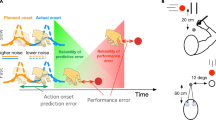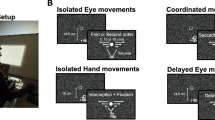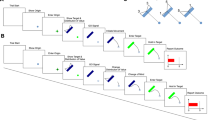Abstract
How long does it take to stop or modify a movement once it has begun? Where there is an error in producing an action as intended (usually because of control-display incompatibility) subjects may correct it in less than their normal reaction time (RT) by proprioception1 or efference-copy monitoring2—4. Where subjects work from a visual (external) error signal, however, they are usually said to take a full RT to stop5 or correct6,7 ongoing movements, so that there is a ‘point of no return’, after which they are committed for about 300 ms to any action decided on8. During this time the action is ballistic at the perceptual-motor level6,9,10. But in a recent tracking experiment11 where subjects wrongly anticipated the target motion, and so began a movement in the wrong direction, the correction time to stop the action (CorT) was often much shorter than the normal RT to initiate movements, down to as little as 120 ms in some cases. This suggests that fast error correction can occur from a visual signal alone, at least to stop movements (as in an emergency). Repeating the experiment we find that movements can indeed be arrested soon after they begin, but only if the beginning is delayed; it always takes one RT from the occurrence of the error signal. We therefore infer that there is a ‘point of no return’ at the decision level, but that movements are not necessarily ballistic at the motor level.
This is a preview of subscription content, access via your institution
Access options
Subscribe to this journal
Receive 51 print issues and online access
$199.00 per year
only $3.90 per issue
Buy this article
- Purchase on Springer Link
- Instant access to full article PDF
Prices may be subject to local taxes which are calculated during checkout
Similar content being viewed by others
References
Gibbs, C. E. Br. J. Psychol. 56, 233–242 (1965).
Angel, R. W. Neurology (Minneap.) 26, 1164–1168 (1976).
Megaw, E. D. Ergonomics 15, 633–643 (1972).
Rabbitt, P. M. A. Nature 212, 438 (1966).
Hick, W. E. Q. Jl exp. Psychol. 1, 175–179 (1949).
Vince, M. Br. J. Psychol. 38, 149–157 (1948).
Craik, K. J. W. Br. J. Psychol. 38, 56–61 (1948).
Bartlett, F. C. Thinking, Chap. 1 (Allen and Unwin, London, 1958).
Searle, L. V. & Taylor, F. V. J. exp. Psychol. 38, 615–631 (1948).
Flowers, K. A. Brain 99, 269–310 (1976).
Flowers, K. A. Ergonomics (in the press).
Klemmer, E. T. J. exp. Psychol. 54, 195–200 (1957).
Welford, A. T. Fundamentals of Skill, 143 (Methuen, London, 1968).
Keele, S. W. & Posner, M. I. J. exp. Psychol. 77, 155–158 (1968).
Author information
Authors and Affiliations
Rights and permissions
About this article
Cite this article
FLOWERS, K. Test of the ballistic hypothesis of movement and the ‘point of no return’. Nature 268, 174–175 (1977). https://doi.org/10.1038/268174a0
Received:
Accepted:
Issue Date:
DOI: https://doi.org/10.1038/268174a0
Comments
By submitting a comment you agree to abide by our Terms and Community Guidelines. If you find something abusive or that does not comply with our terms or guidelines please flag it as inappropriate.



